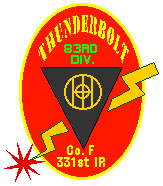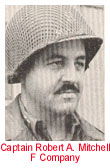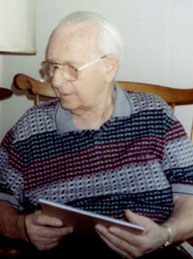



He tells about how he and Shoemaker and a couple of other non-coms confiscated a stateroom on their troop ship. He says he still has the keys to the room somewhere. He tells how he yelled an obsenity at someone who asked about the foxhole he was digging. Terhanko emerged from the hole to find General Eisenhower and his aide looking down at him. He thought for sure that he would be busted. Instead, Eisenhower commended him for his foxhole digging skills.
Then he tells about the bodies he had to step over when they landed at Omaha beach, and about how he was wounded four times and buried alive twice. "I was hell on wheels," he says. "We were all scared, but we had a job to do, and I figured we would do our job and not worry about what would happen to us."
Wounded four times, three times in a three week period, First Sergeant Terhanko never saw the inside of a hospital. The first time he was wounded was on June 29, 1944. He was carrying a bag of hand grenades when German mortars began firing at him. "I was lugging them in one of those double mortar bags. Then the Germans threw in some heavy mortar. Hot shrapnel tore into my hip. An inch closer and it would have cut my spinal cord." He told the runner who was with him to cut the shrapnel out of his hip, but the soldier protested--saying that he did not have a knife. Terhanko pulled out his own trench knife and handed it to his friend. After the impromtu surgery, Terhanko tried to continue his mission, but was bleeding too much. The captain told him to go to the aid station, where they wanted to send him back to a field hospital. He refused to go. So they bandaged him up, loaded him on a jeep with his leg draped over the front, and sent him back to his company.
Terhanko recalls that when they finally made it through the hedgerows they had to cross open terrain between Carentan and Periers. "As we moved along everything was quiet, then all of a sudden the Germans started to fire at us. Six of us ran into a building that looked like a two story house to take cover. It also had a basement or shelter under it which was uncommon for a house in France. Hidden under the first floor were steps leading down to the shelter which was about 10 by 12 feet."
 "The Germans had seen us run into the house and started shelling it.
After a few near misses they scored a direct hit bringing down the building
on top of us. Captain Mitchell tried to call in to report our position but the radio
was knocked out. He finally got the radio operating and reported to the
General, who was not pleased with our progress and sent help
to get us out. "
"The Germans had seen us run into the house and started shelling it.
After a few near misses they scored a direct hit bringing down the building
on top of us. Captain Mitchell tried to call in to report our position but the radio
was knocked out. He finally got the radio operating and reported to the
General, who was not pleased with our progress and sent help
to get us out. "
"It took the outside help about two hours to dig us out while still being shelled. In all we were buried in the rubble for about 5 hours. We rejoined the rest of the company and continued."
Sergeant Terhanko was shelled again during the Brittany campaign. "We arrived late in the afternoon at the base of Hill 48 near the town of St. Briac. We started to set up our night defensive positions. The area contained foxholes and a trench system that the retreating Germans left intact. We were to attack the hill in the morning from the west flank."
"It was decided that this would be a good time to enjoy a hot meal and one was ordered from the rear. It arrived just as it was getting dark. A chow line was started and about half of the men were served before we started getting shelled by the Germans. They were using mortars and artillery. I was straddling a trench directing the men to the chow line. As the rounds started coming in closer I heard one that sounded like it would be real close. I yelled for everyone to get down and dove into the trench I was standing over. The shell hit where my right foot had been, caving in the trench on top of me. I was completely covered with only my two feet sticking out of the ground. "
"The men dug out my head first, or I would have suffocated. After they dug me out I went back to the chow truck and used their water to clean up with. The shelling was over. I was sore, but luckily nothing was broken."
On another occasion, Terhanko was nearly run over by a tank. "We were crossing an open area when all of a sudden three German tanks appeared. They started for us. The area was covered with foxholes that the Germans had dug. I dove into one of them. One of the tanks headed my way and drove over the foxhole I was in. When it got over top of me it stopped and twisted back and forth trying to cave the hole in on me. After trying this the tank moved on along with the other two."
"We waited a few minutes and got out of the holes and started forward again. The tanks continued behind us and we were not bothered by them again."
At the end of the war, Sergeant Terhanko was somewhat reluctant to return home. He had plenty of points, but he said he had it made. Put in charge of a POW camp, Terhanko had a seamstress to repair and clean his clothes and a cook to prepare meals for him. It was quite a change from what he had experienced in the previous year.
It is with great sadness that we report that Mr. Terhanko , 93, of Austintown, Ohio, passed away Sunday morning, December 4, 2005, at Beegly Oaks Nursing Home after a short illness. Mr. Terhanko was born May 26, 1912 in Mount Pleasant, PA, a son of George J. and Mary A. (Sofranko) Terhanko. A decorated World War II veteran. Mr. Terhanko served with the 83rd Infantry division, 331st IR, Company F from October 13, 1942 to July 24, 1945. Mr. Terhanko earned the rank of 1st Sergeant and fought in the battles of Normandy, Northern France, The Ardennes, Central Europe, and The Rhineland. His decorations include the Silver Star, the Bronze Star, the Purple Heart with 3 Oak Leaf Clusters, the European-African-Middle Eastern Campaign Medal with 5 Bronze Stars, the World War II Victory Medal, the Army of Occupation Medal, the Combat Infantryman Badge, the Presidential Unit Citation, the Meritorious Unit Citation, and the Good Conduct Medal. In May of 2005 Mr. Terhanko was inducted into the Ohio Military Hall of Fame for Valor. George retired from the Atlantic and Pacific Tea Company after 38 years in 1975, where he was an Inspector at their Salem Plant. Prior to that he was a Meat Department Manager in various local A&P stores. He was a member of the Wickliffe Christian Church in Austintown and enjoyed golfing. His wife, the former Ruth I. McMeans, whom he married June 11, 1949, passed away August 6, 1999. Mr. Terhanko is survived by a son, G. Richard (Linda) Terhanko of Boardman; a daughter, Marta R. (George) Swauger of Austintown; two grandaughters, Nicole M. and Alexis C. Terhanko, both of Boardman; and two grandsons, George and Adam Swauger of Austintown. Besides his wife, George was preceded in death by his parents, two brothers John and Edward and a sister Mary Graham.
Mr. George Terhanko at home.
